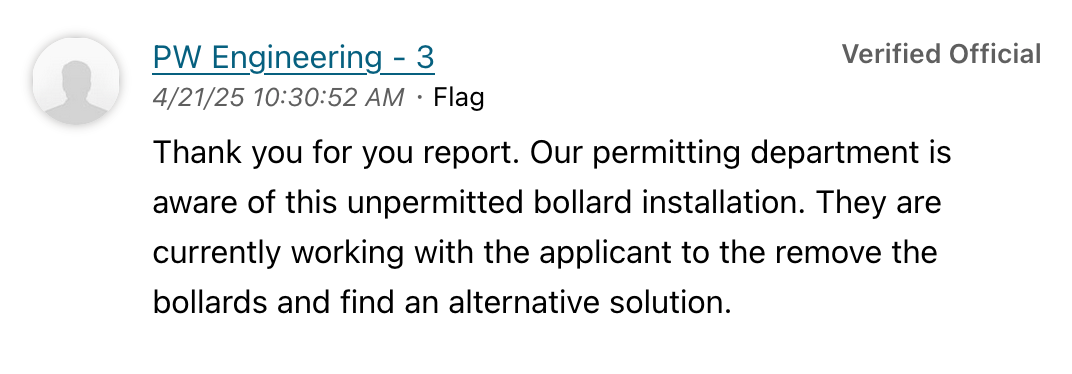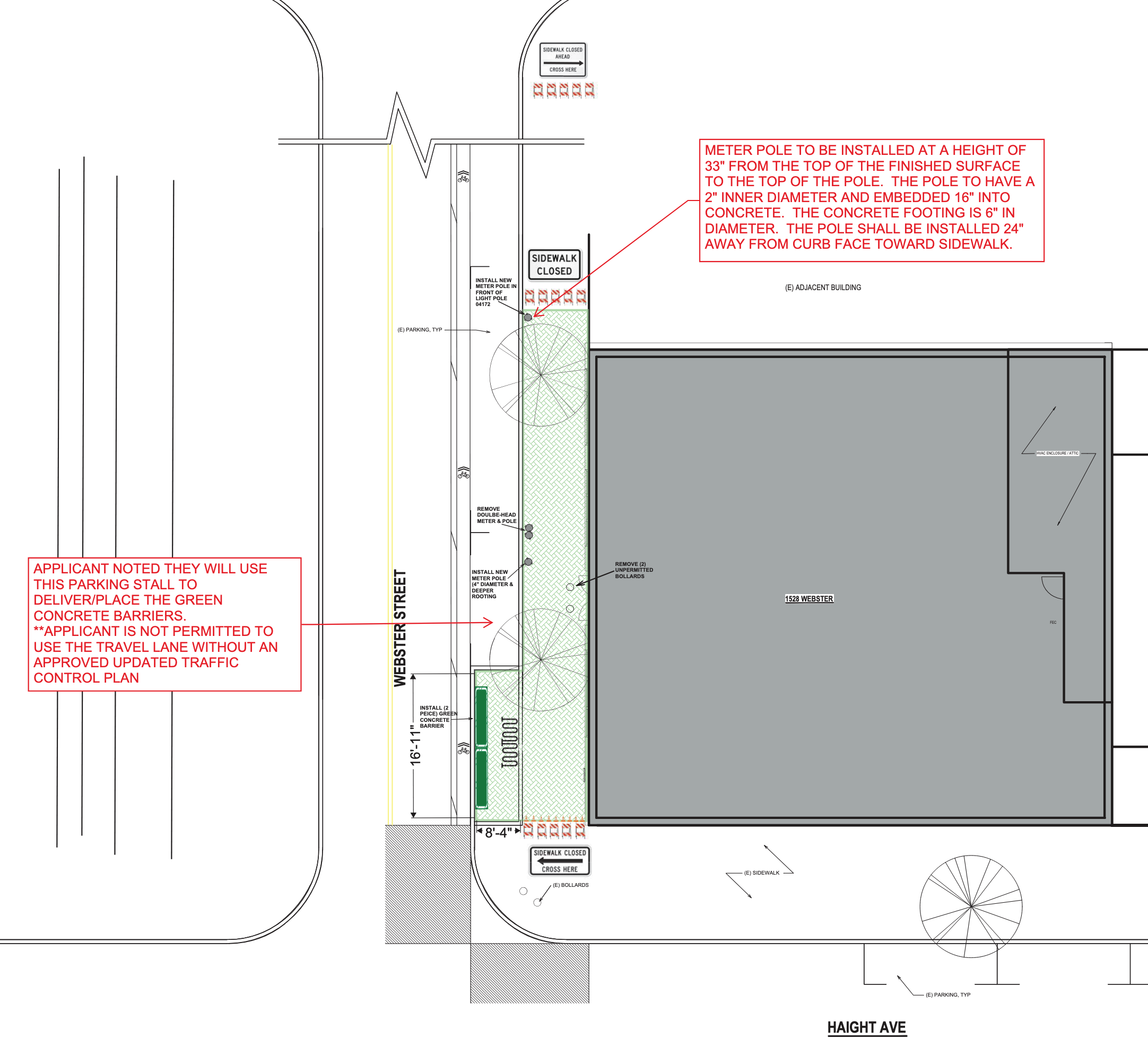For the first time in years, I don't have one or both kids in preschool on the western end of Alameda Island — so I need to find other reasons to get over there. Friday morning I came up with an excuse: I cycled over to Webster Street to see if the dispensary's unpermitted bollards are still jutting out of the sidewalk.
After this blog's post titled "Thinking about PROWAG on a walk around Alameda" went out on Monday morning, a perceptive reader noticed that city staff updated the related SeeClickFix issue some hours later:

Before blogging about the topic again, I thought I better go check in person. And yes, there they are — two posts still standing on Friday morning.
Since my last post, there does appear to have been some action on paperwork in Accela. As of Thursday, the city approved an actual encroachment permit:

I hadn't found this application earlier, since it had been lingering in a held state for over a month (with the applicant apparently not acting on changes requested by city staff).
Also while digging back on Accela, I found the original code enforcement case that started all of this. Turns out the unpermitted posts have been blocking this sidewalk since January. (Note to self: I guess I really don't get to Webster Street as often as I used to :)

On the upside, it does appear that the dispensary will eventually be paying a construction company to remove these unpermitted barriers and to install a permanent solution that is officially blessed by the city. (More on this in a moment.)
On the downside, that apparently wasn't that sternly worded of a letter that the city sent to the dispensary in January given that it still hasn't been acted upon as of my trip over to Webster on Friday. When the city wants something removed, they do have angle grinders and jackhammers and concrete cutting saws — and skilled staff who know how to operate them 24/7 if needed. And when the city doesn't care, well, apparently they send a letter without deadlines or penalties...
Strategically hardening this edge of Webster
In any case, here are the business's plans that have now been approved by the city:

- Removing the unpermitted bollards from the center of the sidewalk, restoring the pedestrian access route (presumably at the business's own expense, although after long delay)
- Placing two concrete barriers in the roadway, between an existing bike rack and the unprotected bike lane (almost turning the bike rake area into a parklet-like enclosure, although at the roadway grade, not the sidewalk level)
- Replacing some of the existing parking meter posts in the furnishings zone along the edge of the sidewalk so that those posts and more deeply seated in the concrete and serve as firmer barriers to potentially halt cars
- The combination of new concrete barriers, existing street trees, and enhanced parking-meter posts will serve as a hardened but semi-porous barrier along this stretch of street frontage, still allowing people to move between the parked cars and the sidewalk.
Here's what I'm taking away from this "process" and this outcome:
Looking back over months of inaction
The City of Alameda hasn't prioritized the needs of those who walk and roll on Webster Street, nor has the city demonstrated a commitment to compliance with PROWAG. What would Ed Roberts say about the City of Alameda's deference to private interests over public accessibility on Webster's sidewalk?
"Eric Dibner, who was an attendant for disabled students at Berkeley in the 1970s, says 'the story that there were midnight commandos is a little bit exaggerated, I think. We got a bag or two of concrete,' he elaborates, “and mixed it up and took it to the corners that would most ease the route,” according a fascinating article/episode about curb cuts by the podcast 99% Invisible.
Thinking ahead more productively
The city's engineers have now approved physical features that harden the edges of this sidewalk along the curb and also extend the protected area into the roadway grade. Rather than treating this sidewalk as "the clear zone" (where drivers are allowed to ditch their vehicles whenever they get a little too speedy or a little too tipsy) this combination of strategically placed concrete barriers and strengthened parking meter posts protects the broader pedestrian realm — even if the stated goal of this project is to just protected the cash and pot brownies (or whatnot) inside this particular store from theft-by-auto.
What if we treated everything as valuable and worthy of protection as the insides of this dispensary? What if we treated human bodies on our streets as preciously as the adult gummies inside this store?
What if for the next project like this, the stated goal was to protect the entire sidewalk and its occupants — and perhaps even the adjoining bike lane and its users as well?
To offer one specific example
Given that the city's engineers now permit concrete barriers and posts rooted deep in concrete (without breakaway bolts) on sidewalk edges and also within major corridors, I look forward to seeing similar treatments used to slow down and slim down Ralph Appezzato Memorial Parkway. Two different women on foot have been killed by motorists at the exact same intersection along RAMP and Coral Sea Street, one while on the sidewalk and the other while within a crosswalk. The city's Rapid Response after Fatal Crashes Program is presumably working on this area.
If the marijuana entrepreneurs have enough alacrity to install illegal bollards into the public right-of-way, ignore letters from the city for months, and then get approval from engineers to install more strategically fixed posts and concrete barriers than are on any other sidewalk in town, then let's see more of that chutzpah from the city itself — in service of safety and accessibility for the general public.